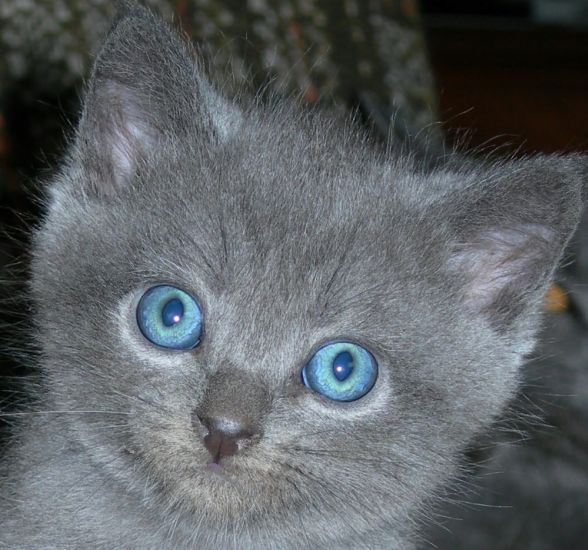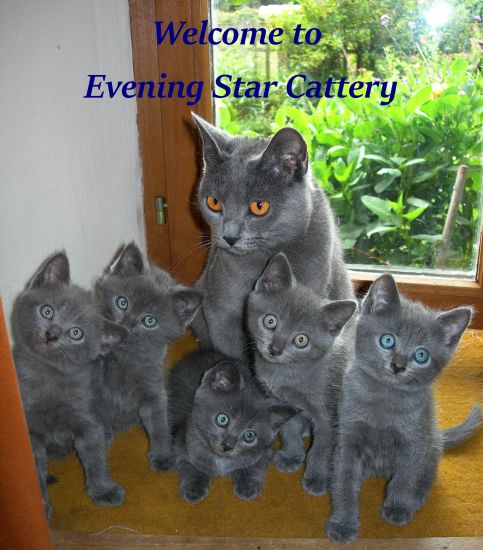The Chartreux
Chartreux Kittens Available 2023
We have a new litter and there are kittens available for reservation.You can see our cattery televised on French television and visible on Youtube.

|
All kittens leave with the standard series of vaccinations and will be registered with the international governing body Fifé for their pedigree certificate. Kittens going to France will need a pet passport and a rabies vaccination. This is not a requirement for kittens destined for the UK.
You can contact us by phone on 07624 568722 or by filling in the information request form.
The Chartreux, Famous Old French Breed
We breed only chartreux and our kittens are raised in our home in front of the fire or on the setee in the winter or gazing out of the window at the birds in the summer.The chartreux is a strong sturdy short haired cat who loves company and adores being caressed; a quiet cat but not one to withhold his purs of appreciation.
The chartreux is often confused with the british shorthair but once you get to know them, they are quite different both in appearance and character. Our cattery was born out of our love for this very special breed. This French cat is recognised by the fife affiliate Felis Britannica in the UK.

|
The Chartreux
The Chartreux is a traditional French breed much loved throughout the world. The Chartreux is a short haired cat with a blue coat and golden or copper coloured eyes. By the uninitiated it is sometimes called a grey cat but if you place it next to a charcoal grey cat you can see the blue reflection of the fur. The colour can be a pale blue grey through to a darker slate blue. However the coat must be uniform throughout except as described in the paragraph below on kittens. The coat is dense and woolly and tends to break into ridges like sheep's wool.It is a powerful, muscular, well built cat but nevertheless with a sweet character and a kitten well raised will rarely scratch or bite. The Chartreux is a quiet cat unlike many other breeds and will normally only meow to show that it is in need of something. However it is not slow in purring to show its appreciation. It is playful and even into its old age will continue to play with its toys, mice, feathers and such. The Chartreux is traditionally a great hunter.
The Origin of the Chartreux
There are many legends about where the Chartreux came from, perhaps the most popular being that it was brought over from the Middle East during the time of the Crusades or perhaps in merchant ships. Some believe that it gets its name from the Chartreux monks who kept these cats to chase the rats from their grain silos and bred them to be quiet cats so that they would not disturb the monks in their meditation.The earliest records of a Chartreux as a companion can be found in the writings of Joachim du Bellay in the 16th century. Since then various famous people have owned a Chartreux The Leger sisters played a big role in promoting the Chartreux in France. They lived on a small island called Belle-Ile off the west coast of France where they fell in love with the beautiful blue cats that roamed free on the island.
Chartreux Kittens
 Blue-eyed chartreux kitten
Blue-eyed chartreux kittenThe kittens are born with their eyes closed. These will open between 5 and 10 days. If the eyes are slow to open, it may be necessary to gently help to open them because of the danger of infection if they remain shut too long.
The colour of the eyes is blue for the first few weeks. After about 5 weeks the colour will start to change and will pass through various shades before the adult colour begins to establish itself. Looking at the photo of mother and kittens at the top of the page, you can see the evolution of the eye colour. The colour is in the process of changing and although these kittens are all of the same litter, you can see that the change is more advanced in some of them. Chartreux kittens are born with blue eyes and it is only after about four or five weeks that the colour starts to change towards the gold/copper colour of the adult cat.
A marriage between a light coloured cat with one with a much darker coat can give phantom light/dark makings across the body of the kitten and similar rings on the tale. These markings will gradually disappear as the kitten grows and should have disappeared completely by the time it has reached adulthood
Male or Female
The choice between a male and a female is very subjective. The male is impressive with his large head and jowls. He is perhaps a little sweeter and calmer than the female who has a more elegant look and can be more mischievous.Castration / Sterilisation
Most males will start to mark their territory by spraying. This may start somewhere around 8 or 9 months but could be later. Some females may also display this behaviour to a more limited extent. For a male it is preferable not to castrate too early because this can hinder the development and growth. However castration will normally lead to a calmer, happier cat.Sterilisation of the female plays an important role in the prevention of ovarian, uterus and mammary cancers.
Diet
The basic food should be dry biscuits but occasional treats may be given and this can help the bond with the owner. A bowl of fresh water should always be available and milk should be avoided.Health and Care
The Chartreux is a robust cat that has very few health problems. Occasional brushing and grooming can be beneficial and promotes the bond between the cat and the owner. The cat should receive annual vaccinations. Uncastrated males can be more prone to struvite and calcium oxalate stones which need to be dealt with immediately.Indoors or Outdoors
The Chartreux is a cat that will stay quite happily indoors, particularly if it has never roamed outside. A male that has not been castrated and allowed out will seek out females in the surrounding area. He may travel far to accomplish his goal and could go missing for periods of time. There is the consequent risk of disease such as feline AIDS. Unfortunately the risk of theft of a pedigree cat is not negligible.The Smiling Cat
The Chartreux is sometimes known as the smiling cat. There is no specific mention of the Chartreux in Alice in Wonderland but the description of the smiling cat does make one think of the Chartreux. "Please would you tell me," said Alice, a little timidly, for she was not quite sure whether it was good manners for her to speak first, "why your cat grins like that?"Cross Breeding
There was a time when cross-breeding was allowed to a certain extent with for example the British Shorthair but such practice has now been forbidden since 1977.| Further Information |
|---|
|
You can find further information on the Evening Star cattery together with photos of our cats and kittens at our main website site. Click on the appropriate flag to change the language between English and French. We are also present on facebook. |
 Evening Star main website
Evening Star main website